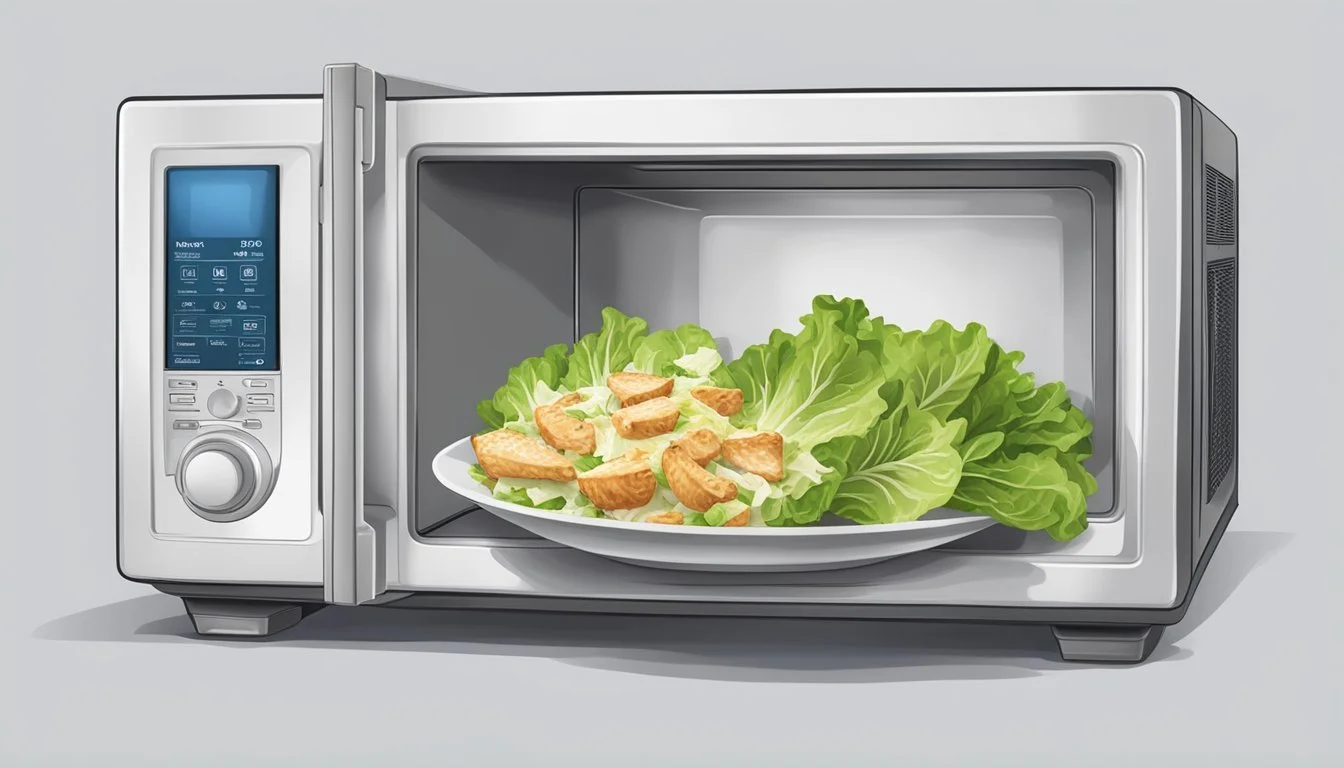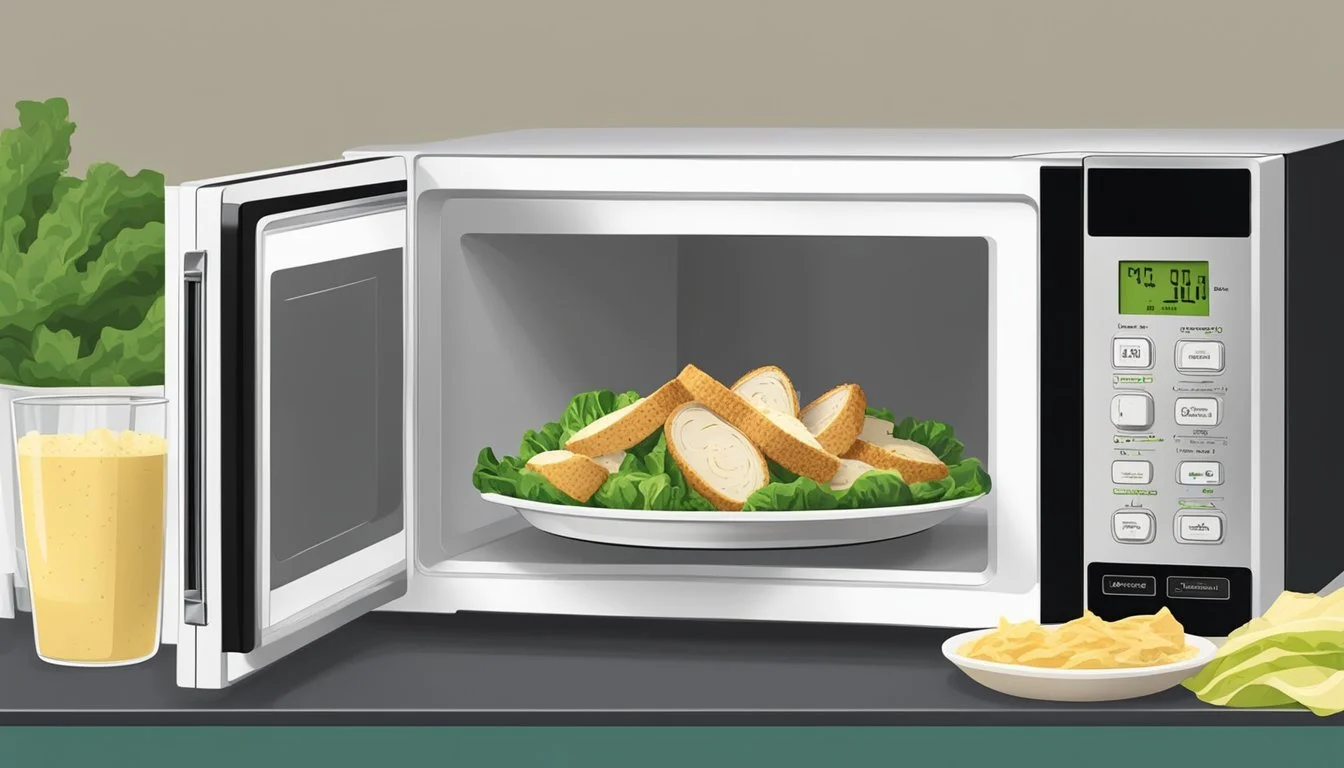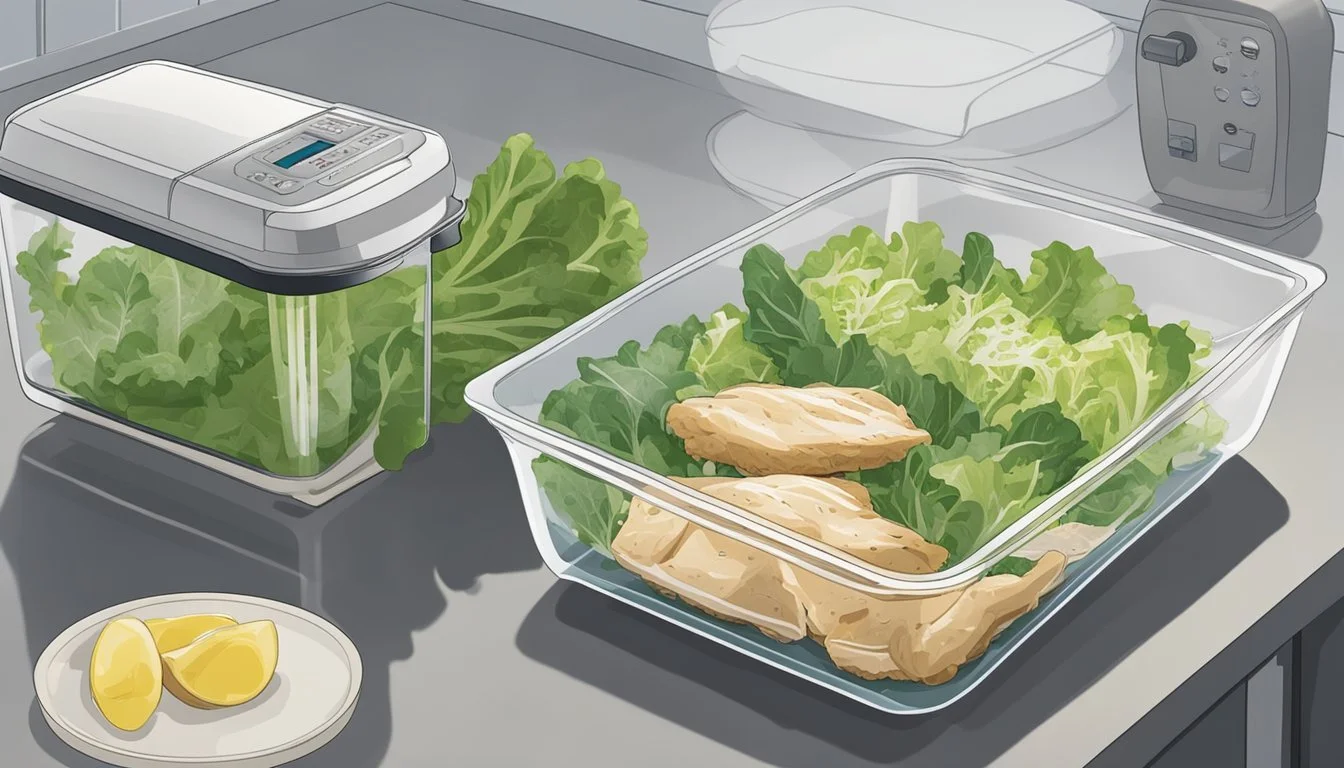Best Way to Reheat a Chicken Caesar Salad
Ensuring Crisp Lettuce
Reheating a chicken Caesar salad while keeping the lettuce crisp is a delicate task that requires careful separation of ingredients and an understanding of how to properly reheat chicken without compromising the salad's freshness. Lettuce, as a tender and crisp leafy green, can easily wilt or become soggy if not handled correctly during the reheating process. To maintain the quality of a Caesar salad, one must consider both the chicken and the greens separately.
The key is to reheat the chicken to a perfect temperature where it regains the warmth and texture as if it was freshly cooked, without affecting the cool, crisp nature of the salad itself. The ideal method keeps the chicken moist and flavorful, typically achieved by oven reheating or using a toaster oven. Simultaneously, the lettuce demands a completely different approach to ensure it retains its crunch and doesn't wilt from any residual heat of the chicken.
Reassembling the chicken Caesar salad after the appropriate reheating of the chicken is the final step. The lettuce should be chilled, perhaps even lightly refreshed in cold water and thoroughly dried if it has lost some of its crispness during storage. By doing so, a delightful contrast between the warm, savory chicken and the cool, crisp lettuce can be established, mirroring the experience of a freshly made Caesar salad.
Understanding the Challenges of Reheating Salad
Reheating a salad, particularly one with a delicate composition like a Chicken Caesar Salad, brings certain challenges that require careful techniques to maintain its quality. Avoiding the pitfalls of wilting lettuce and ensuring food safety are paramount.
Maintaining Crispness
The key to crisp lettuce in a reheated salad lies in managing moisture. Lettuce and other salad greens have a high moisture content, which quickly turns to steam when heated. This process can leave leaves limp and unappetizing. To preserve the crunch, one must avoid exposing the greens to direct heat or prolonged warmth.
Preventing Soggy Greens
Soggy greens result from excessive moisture and are a common issue during reheating. The delicate nature of these leaves means they wilt rapidly, especially in a warm environment. To prevent a soggy salad, separate the greens from other components and only reheat elements that benefit from warming, like the chicken. A salad is often composed of layers, and deconstructing these layers before reheating can preserve freshness and texture.
Avoiding Spoilage and Food Safety Issues
Salads are typically perishable foods, sensitive to temperature changes and prone to spoilage. Ensuring food safety involves keeping the salad within a safe temperature range to prevent oxidation and the growth of harmful bacteria. Reheat the protein component to an internal temperature of 165°F, as recommended by food safety guidelines, and promptly consume or refrigerate the salad to minimize the risk of spoilage.
Pre-Reheating Preparation
Proper pre-reheating preparation of a Chicken Caesar Salad is essential to maintain the salad's freshness and texture. The condition of the salad and its ingredients should be carefully assessed, with certain components separated before applying any heat.
Assessing Salad Condition
One must first evaluate the freshness of the Chicken Caesar Salad leftovers. The lettuce should appear vibrant and crisp, without any signs of wilting or browning. If the salad includes croutons, they should remain dry and crunchy. A salad spinner can be employed to reinvigorate leaves which are slightly limp but not spoiled. Any components that manifest spoilage should be discarded immediately to avoid foodborne illness.
Separating Ingredients
To preserve the distinct textures within the Chicken Caesar Salad, it's imperative to separate the ingredients:
Lettuce: Remove the lettuce and store it in a salad spinner or wrap it in paper towels to absorb excess moisture, then place it inside an airtight container in the refrigerator.
Chicken: Place the chicken in a separate container. If it's chilled, allow it to come to room temperature to ensure even reheating.
Croutons and Other Dry Ingredients: Set aside croutons and any other dry toppings to prevent them from becoming soggy.
Dressing: Ideally, the salad dressing should be stored separately. If the salad is already mixed with the dressing, the leaves may be prone to sogginess and may not be suitable for reheating. However, if dressing is minimal, it may be possible to salvage the salad by removing excess dressing before reheating.
By following these steps, the integrity of a Chicken Caesar Salad's components is better maintained, leaving the foundational prep work complete for reheating.
Effective Reheating Techniques
To reheat a Chicken Caesar Salad while keeping the lettuce crisp, it’s essential to separate components and understand the proper application of heat. Employing the right technique ensures that the lettuce remains crisp and the protein is warmed through without becoming dry.
Utilizing Dry Heat
For the lettuce and vegetables, such as romaine, kale, and croutons, a dry heat method in an oven can be effective. They should never be reheated as this will cause wilting and loss of crunch. Instead, the user can refresh the lettuce by storing it in the fridge in a container lined with a dry towel to absorb excess moisture.
Microwave Reheating Tips
When dealing with the protein component of a Chicken Caesar Salad, the microwave can be a quick reheating option if done correctly. The user should place the chicken in a microwave-safe dish, add a splash of water to maintain moisture, and cover loosely with a lid or damp paper towel. Heat it in short bursts at 50% power to avoid overcooking. The lettuce and croutons should not be microwaved, as they will quickly lose their firm texture and crispness.
Stovetop Warming Methods
For reheating the chicken on the stovetop, one should place it in a skillet with a small amount of water or chicken broth and gently warm it over medium heat. The objective is to achieve a temperature where the chicken is hot but not dried out. The greens and croutons of the salad should be kept at room temperature or chilled, away from the stove, to preserve their freshness and firmness.
Post-Reheating Tips
After carefully reheating your chicken, it is crucial to address the salad components separately to maintain the dish's integrity and texture. The lettuce should remain crisp, and the dressing vibrant to ensure the Caesar salad experience is unaltered.
Dressing Application
To prevent the lettuce from becoming soggy, one should apply the salad dressing after reheating the chicken. Do not mix the dressing with the warm chicken directly as it can wilt the greens. Instead, gently drizzle the dressing over the cool, crisp lettuce to maintain balance and texture. For a classic Caesar flavor, the dressing should include ingredients such as mayonnaise, olive oil, citrus juice from lemon, garlic, anchovy, Worcestershire sauce, vinegar, and mustard for depth and tanginess.
Final Touches for Freshness
The lettuce's freshness is the cornerstone of a good Caesar salad. To ensure that the greens stay fresh and crisp, one should store the lettuce in an airtight container with a damp paper towel to keep the moisture level balanced. After adding the warm chicken and dressing, they can add a final sprinkle of lemon juice for a fresh citrus note. For an added crunch, one might consider tossing in freshly made croutons, lightly seasoned with garlic and olive oil to complement the Caesar profile.
Alternative Solutions and Tips
When reheating a Chicken Caesar Salad, the texture of the lettuce and the warmth of the chicken should be balanced carefully to maintain the salad's appeal.
Opting for Cold Chicken Caesar Salad
Choosing to consume the chicken Caesar salad cold can preserve the lettuce's crispness. For those who prefer their protein at room temperature, they may remove the chicken from the fridge ahead of time, allowing it to gently come to room temperature without compromising the firmness of the romaine lettuce.
Best Practices for Storing Salad
Proper storage is key to keeping a Caesar salad fresh. Users should ensure to use an airtight container to store the salad in the fridge to prevent wilting. Placing a dry paper towel in the container helps absorb excess moisture and keeps the salad dry. For optimal freshness, salad dressings like vinaigrette or creamy mayonnaise and yogurt-based dressings should be stored separately and added just before serving.
Vegetables: Keep them dry and refrigerated. Use a salad spinner to remove excess water from the lettuce.
Add-ins: Tomatoes, cucumber, and other moisture-rich vegetables should be added fresh if possible, to avoid excess moisture impacting the salad's texture.
Dressing: Creamy dressings need special attention. Separating the dressing and applying it right before eating is advisable to keep the lettuce from becoming soggy.
By following these storage guidelines and considering the consumption of the chicken cold, one may enjoy a Chicken Caesar Salad that is as close to freshly made as possible.
Maximizing Salad Freshness and Longevity
When looking to keep a Caesar salad crisp and fresh, whether for personal enjoyment or for serving at a later time, employing correct storage methods and understanding how to extend the ingredient's shelf life is crucial. These practices ensure that the lettuce remains firm and the overall salad maintains its integrity before reheating.
Proper Storage Methods
Lettuce and leafy greens: To maintain the freshness of lettuce and leafy greens, start by washing and drying them thoroughly. A salad spinner can be useful for removing excess water. Store the greens in an airtight container or a resealable plastic bag, placing a paper towel inside to absorb any additional moisture. Keep this in the refrigerator's crisper drawer to preserve the crispness.
Use of containers:
Store salad in a sealed container.
Include a paper towel to absorb moisture.
Keep the container in the fridge.
Dressing and other additions:
Keep salad dressing separate until ready to serve.
Avoid storing delicate ingredients like parmesan cheese and croutons with the greens.
Air circulation:
Ensure the container allows for some air circulation to prevent wilting.
Avoid overcrowding the container to keep greens from getting crushed.
Extending Shelf Life of Ingredients
Freshness can often be prolonged by managing the ingredients carefully.
Prep your ingredients:
Cut firm vegetables like broccoli and cauliflower for the week and store them in airtight containers.
Cooked ingredients such as chicken or bacon should be refrigerated promptly and consumed within a safe time frame.
Expiration awareness:
Monitor expiration dates on items like dressings and add-ons like croutons.
Label containers with prep or storage dates to ensure ingredients are used at their peak freshness.
By following these methods, one can significantly prolong the freshness and enjoyment of a Caesar salad, keeping it ready and appetizing for the next meal whether it be lunch or dinner.






